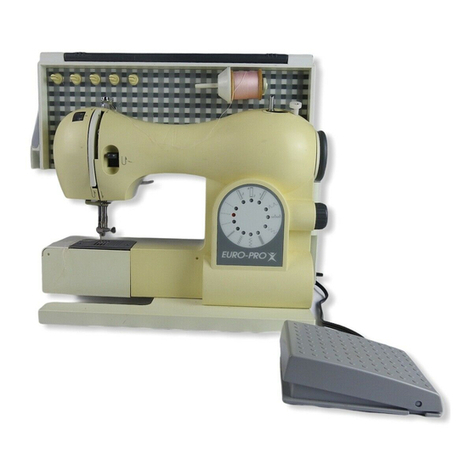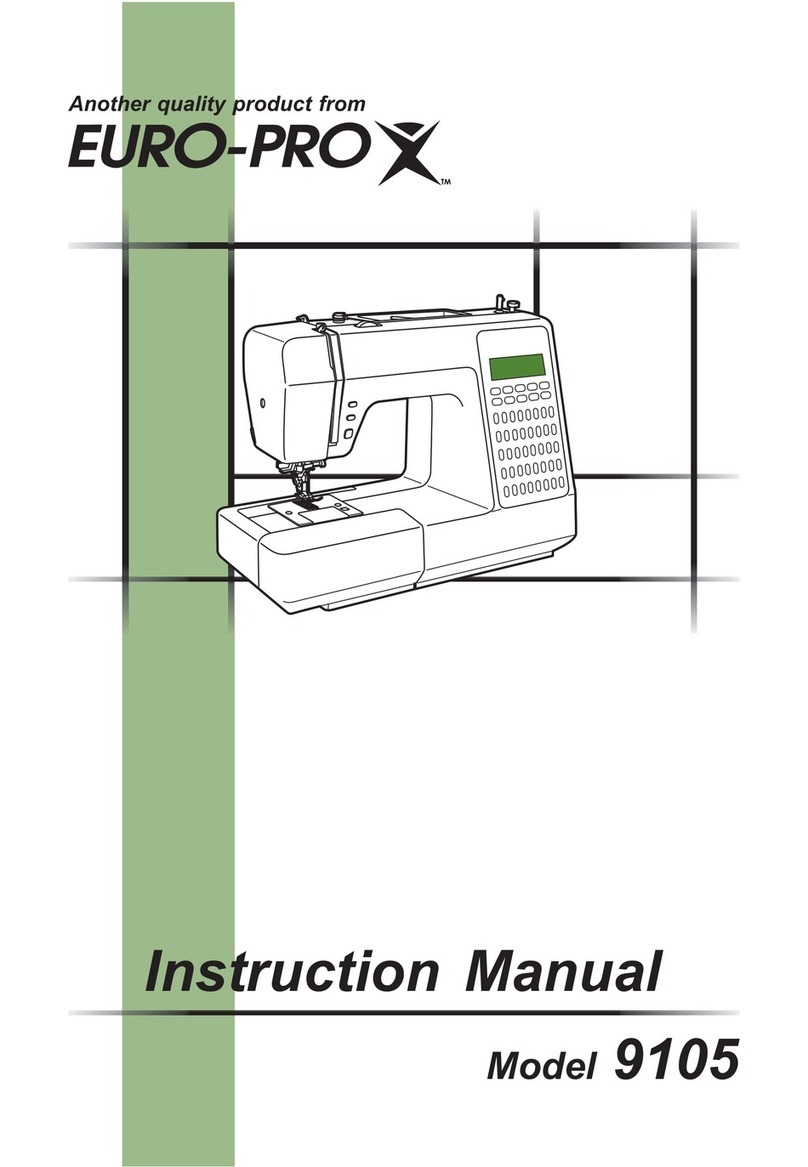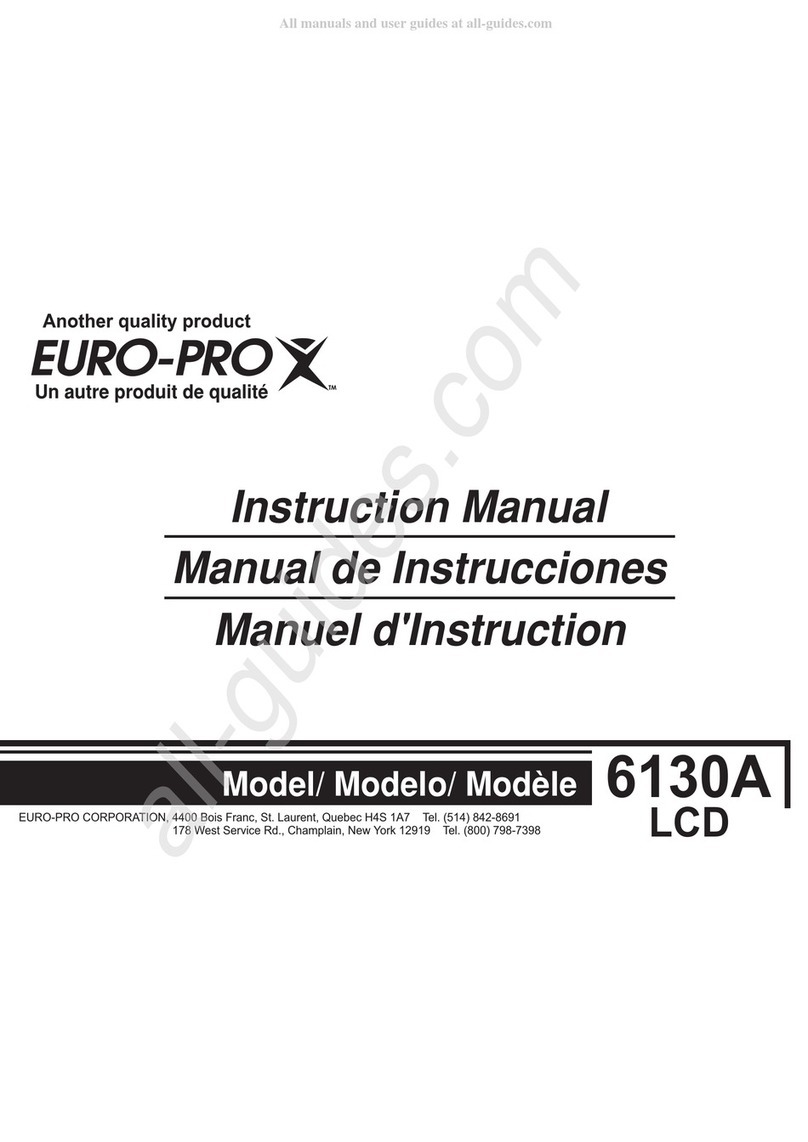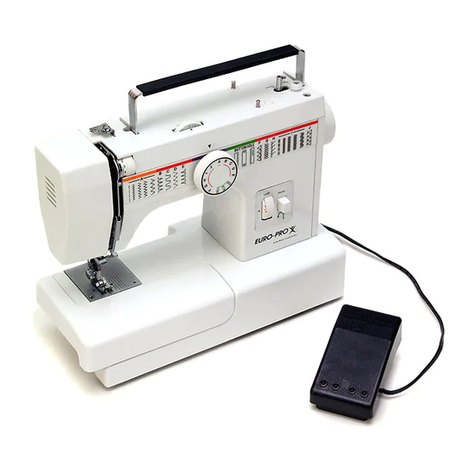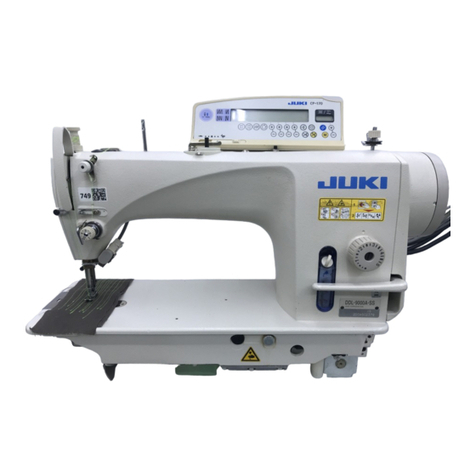EUROPRO Shark 101-548 User manual

INSTRUCTION MANUAL
Model 101-548
EURO-PRO Operating LLC: 94 Main Mill Street, Door 16, Plattsburgh, NY 12901 Tel.: 1 (800) 361-4639
4400 Bois Franc, St. Laurent, Quebec H4S 1A7 Tel.: 1 (800) 361-4639

101-548
PREFACE
Thank you for your purchase of this serger. This machine intended for household use will provide you with
excellent performance in sewing from light to heavy material (lawn to denim). Please refer to this booklet for
proper use and optimum service. To get the most from your sewing machine, read the entire Instruction Manual
before attempting to operate the machine. Then familiarize yourself with the machine, by following the
Instruction Manual page by page.
To ensure that you are always provided with the most modern sewing capabilities, the manufacturer reserves
the right to change the appearance, design or accessories of this serger when considered necessary without
notification or obligation.
1

IMPORTANT SAFETY INSTRUCTIONS
When using this machine, basic safety precautions should always be followed including the
following. Read all instructions be fore using th e machine.
DANGER - To reduce the risk of electric shock:
• The machine should never be left unattended when plugged in. Always unplug the machine from the electric
outlet immediately after using and before cleaning.
•Always unplug before relamping. Replace bulb with the same type rated 15 watts. Be sure to replace the face
plate which covers the light bulb before operating the machine.
- To reduce the risk of burns, fire, electric shock or injury to persons:
• Be sure that the electrical voltage of the electrical outlet (wall receptacle) is the same as the rated voltage of the motor.
•Use this machine only for its intended use as described in this instruction manual. Use only attachments recommendedby
the manufacturer as contained in the instruction manual.
• To disconnect turn all controls to the off (“O”) position, then remove plug from outlet.
• Disconnect the power line plug from the socket outlet or switch the machine off when making any adjustments in the area,
such as threading needle and loopers, changing needle, changing throat plate or changing presser foot, etc.
• Always unplug the machine from the electrical outlet when removing covers, lubricating, or when making any other user
servicing adjustments mentionedin the instruction manual.
•Do not attempt to adjust the motor belt. Contactyour nearestService Center should anyadjustment be required.
•Do notunplug by pulling on cord. To unplug, grasp the plug,notthe cord.
•Handle the foot controller with care and avoid dropping it on the floor. Be sure notto place anything on top of it.
•Always use the proper throat plate. Thewrong plate can cause the needle to break.
•Do notuse bent needles.
•When sewing, keep fingers away from all moving parts. Special care is required around the sewing machine needle.
•Do notpull or push fabric while stitching. It may deflect the needle causing it to break.
•For double insulated machines,when servicing use onlyidenticalreplacement parts. See instructions for Servicing of
Double-Insulated Appliances.
• Use only the handle to lift and move the machine.
•Ne ver operate the machine if it has a damaged cord or plug, if it is not working properly, if it has been dropped or
damaged, or dropped into water. Return the machine to the nearest authorized dealer or Service Center for examination,
repair, electrical, or mechanical adjustment.
•Ne ver operate the machine with any air openings blocked. Keep ventilation openings of the machine and foot controller
free from the accumulation of lint, dust and loose cloth.
•Ne ver drop or insert any object into any opening.
•Do not use outdoors.
•Do not operate where aerosol (spray) products are being used or where oxygen is being administered.
•Do not allow to be used as a toy. Close attention is necessary when the machine is used by or near children.
•Do not expose the machine or machine plastic case to sunlight directly. Also do not keep It in a very warm or damp
place.
•Do not touch the machine, foot controller and power line cord with wet hand, wet cloth or with anything wet.
•Do not connect power line cord to one of the many cords connected to one power outlet with adapters.
• Use machine on a flat and stable table.
• Be sure to close the cylinder cover and looper cover before operating the machine.
• Keep presser foot and needles away from children’s reach.
• Be sure the light bulb has cooled off before changing with a new one.
• Do not dismantle or modify the machine yourself.
• Be sure to turn off the power switch and disconnect the power line plug before caring for your machine as instructed in the
instruction manual.
• The motor will work normally under the following condition: height above sea level less that 1000m; environment
temperature range -10 °C - 40 °C; environment humidity less than 90% (at 25 °C) and will run 500 hours under rated
voltage / frequency and rated load (ON 7.5s, OFF 7.5s).
SAVE THESE INSTRUCTIONS
Servicing should be performed by an authorized service representative.
This product is intended for household use only.
POL AR AIZED PLUG INSTRUCITONS
WARNING: To reduce the risk of electric shock, this appliance has a polarized plug (one blade is wider
than the other). This plug will fit in a polarized outlet only one way. If the plug does not fit fully in the outlet,
reverse the plug. If it still does not fit, contact a qualified electrician to install the proper outlet. Do not modify the
plug in any way.
2
WARNING:
Rev. 10/05

CONTENTS
3
Selection Of Stitches ..................................................... 4
Handy Reference Chart .................................................. 5
Accessories .................................................................. 6
Needle Information ........................................................ 6
Principal Parts ............................................................... 7
How To Open Front Cover ............................................. 8
Principal Parts Behind Front Cover ............................... 8
Preparation Prior To Sewing .......................................... 8
Attaching And Removing The Waste Container ............ 9
How To Remove And Insert The Needles ..................... 10
How To Attach And Remove The Presser Foot ............. 11
Preparing The Serger for Threading .............................. 12
Threading The Machine ................................................. 13
Threading The Upper Looper ......................................... 13
Threading The Lower Looper ......................................... 14
Threading The Right Needle .......................................... 16
Threading The Left Needle ............................................. 17
How To Change The Threads .......................................... 18
How To Adjust The Stitch Length ..................................... 19
How To Adjust The Seam Width ...................................... 19
How To Adjust The Presser Foot Pressure ..................... 20
Differential Feed .............................................................. 20
Gathered Overedge ........................................................ 21
Free Arm Sewing ............................................................ 22
Standard Overedge And Rolled Hem Stitching .............. 23
Chaining Off And Test Sewing ....................................... 24
Suggested Tension Settings .......................................... 25
- 2-Thread Warped Edge Overlock .......................... 25
- 2-Thread Overedge ................................................ 26
- 3-Thread Overlock ................................................. 27
- 3-Thread Flatlock ................................................... 28
- 3-Thread Wrapped Edge Overlock ........................ 29
- 3-Thread Ultra Stretch Mock Safety Stitch ............ 30
- 4-Thread Ultra Stretch Mock Safety Stitch ............ 31
How To Sew a Rolled Hem ........................................... 32
- 3-Thread Standard Rolled Hem Stitching .............. 33
- 3-Thread Upper Looper Thread Wrapped
Rolled Hem Stitching .............................................. 33
- 2-Thread Standard Rolled Hem Stitching .............. 34
- 2-Thread Upper Looper Thread Wrapped
Rolled Hem Stitching ............................................. 34
- To Secure The Rolled Hem Thread Chain ............ 35
How To Sew a Flatlock Decorative Seam .................... 36
Decorative Flatlocking .................................................. 37
How To Sew An Overlock Blind Seam ......................... 38
How To Sew Pin Tucks ................................................ 39
Turning Square Corners .............................................. 40
- How To Sew Outside Corners .............................. 40
- How To Sew Inside Corners ................................. 41
Pin Placement .............................................................. 42
Securing The Thread Chain ......................................... 42
Reinforcing A Seam ...................................................... 42
Braiding By Chaining Off .............................................. 43
Machine Maintenance ................................................... 44
- How To Clean The Machine ................................... 44
- How To Oil The Machine ........................................ 44
- How To Change The Stationary Knife .................... 44
- How To Change The Light Bulb .............................. 45
Optional Accessories ..................................................... 46
Touble Shooting ............................................................. 47
Comparison Chart Of Sewing Materials,
Threads And Needles .................................................... 48
Specifications ................................................................ 49
Warranty ........................................................................ 50

SELECTION OF STITCHES
This machine is capable of producing various types of stitches according to the combination of needle positions,
threading methods, tension adjustment, and use of convertible right looper/spreader
* Depending on the needle positions used, this machine can sew 2-thread and 3-thread combinations with width of 3.5mm overedge
and a 5.7mm wide overedge seams.
For overedging heavyweight fabrics, the seam width can be increased still more by turning the overedge seam width adjustment
knob. (See page 28)
BlueGreenNeedle Thread Tension Dial
Overedge left needleOveredge right
needle
Needle Used
5.7mm
3.5mmOveredge Width
BlueGreenNeedle Thread Tension Dial
Overedge left needleOveredge right
needle
Needle Used
5.7mm
3.5mmOveredge Width
Page #
Stitch Type
29
1-needle 3-thread stitch is used for sewing
narrow rolled hems or ornamental edges. Also,
a 3.5mm and 5.7mm wrapped overlock seam
width can be obtained by changing the needle
position.*
5. Three-thread
Wrapped Edge
Overlock
30
2-needle 3-thread stitch which is ideal for
lightweight, extremely stretch fabrics such as
tricot and spandex.
6. Three-thread
Ultra-Stretch Mock
Safety Stitch
31
2-needle 3-thread stitch which is ideal for
medium to heavy weight stretchy fabrics such
as double knits and swim wear.
7. Four-thread Ultra-
Stretch Mock
Safety Stitch
28
1-needle 3-thread stitch is used for butted or
lapped seams and ornamental stitching with
decorative thread. Also, a 3.5mm and 5.7mm
flatlock width can be obtained by changing the
needle position.*
4. Three-thread
Flatlock
27
1-needle 3-thread stitch is used for overedging
and seaming on common fabrics. Also a 3.5mm
and 5.7mm overlock seam width can be
obtained by changing the needle position.*
3. Three-thread
Overlock
26
1-needle 2-thread stitch is used for overedging
common fabrics. It is also ideal for flatlock
(butted or lapped) seams and blind hemming.
Also, a 3.5mm and 5.7mm overedge seam width
can be obtained by changing the needle
position.*
2. Two-thread
Overedge
25
1-needle 2-thread stitch is used for seaming
lightweight or stretch fabrics. Also ideal for rolled
hemming. Also, a 3.5mm and 5.7mm overlock
seam width can be obtained by changing the
needle position.*
1. Two-thread
Wrapped Edge
Overlock
4

2.0
1.0
2.52.0
2.0
7.0
7.0
0.5
0.5
3.0
Looper3.0
5.7mm
6.0
5.5
5.0
5.50.5
Looper0.5
5.7mm
2.0
2.0
2.5
2.53.0
Looper2.5
5.7mm
6.0
6.0
0.5
0.5
5.7mm
1.0
1.5
3.0
3.0
5.7mm
Four-Thread
Ultra-Stretch
Mock Safety
Stitch
Three-Thread
Ultra-Stretch
Mock Safety
Stitch
Three-Thread
Wrapped Edge
Overlock
Three-Thread
Flatlock
Three-Thread
Overlock
Two-Thread
Overedge
Two-Thread
Wrapped Edge
Overlock
YellowOrangeGreenBlue
31
Looper2.5
7
30
3.0
6
29
Looper
3.5mm
5
28
Looper
3.5mm
4
27
Looper
3.5mm
3
26
3.5mm
2
25
3.5mm
1
Page
Upper
Looper or
Tension Dial; Numbers shown are average
settings on medium weight fabric with
standard #80 polyester spun thread
Needle
PositionStitch Type
•For 4-thread M/C
The thread tension becomes tighter as the dials are turned to higher numbers. The tension settings shown on this page
as well as throughout the operator’s manual are suggested guides. Adjust thread tensions to suit the fabric and size of
thread used. For best results make tension adjustments in small increments of no greater than half a number at a time
5
HANDY REFERENCE CHART
Converter
Converter
Converter
Converter
Converter
Converter

NEEDLE INFORMATION
Accessories are contained in the accessory compartment
on the side of the machine.
1
1
1
1
1
4
1
1
1
1. Needle set
2. Screw driver (large size)
3. Screw driver (small size)
4. Tweezers
5. Brush
6. Knife (stationary)
7. Thread unwider spool cap
1
1
2
1
1
1
unwider spool cap
This overlock uses a flat shank domestic needle that
eliminates the possibility of inserting the needle backwards.
Do not attempt to use an industrial sewing machine
needle of any size or type in this overlock.
Needle size 14 is furnished with the machine. Regular point
needles for sewing woven fabrics and ball point needles
are available for sewing knits. Both types are available in
sizes 10, 12 & 14.
Refer to the chart on page 65 for selecting the correct
needle for your sewing projects.
.
.
.
.
ACCECSSORIES
Sewing
Surface
Accessory
Compartment
10
12
14
10
12
14
Sizes
available
Ball Point
Knit
Regular Point
Woven
10
12
14
10
12
14
Sizes
available
Ball Point
Knit
Regular Point
Woven
101-548
8. 2 Thread adapter
9. Foot control
10. Machine cover
10
6

PRINCIPAL PARTS
1. Thread Guides & Holder
2. Carrying Handle
3. Lower Looper Thread Tension Dial (Yellow)
4. Upper Looper Thread Tension Dial (Orange)
5. Right Needle Thread Tension Dial (Green)
6. Left Needle Thread Tension Dial (Blue)
7. Needle Plate
8. Sewing Table
9. Front Cover
10. Differential Feed Adjusting Lever
11. Power “On” & Light Switch
12. Handwheel
13. Stitch Length Dial
14. Spool Stand
15. Cone Adapter
16. Spool Pin
17. Presser Foot Lifter
18. Accessory Compartment
19. Waste Container
7

HOW TO OPEN LOOPER COVER (Fig. 1)
PREPARATION PRIOR TO SEWING
(Fig. 3)
PRINCIPAL PARTS BEHIND LOOPER
COVER (Fig. 2)
Caution:
Be sure to turn the “On/Off” switch to the “Off”
position.
1. Push the cover to the right as far as it will go.
(A)
2. Pull the cover down towards you. (B)
Caution:
Be sure the looper cover is closed when sewing.
1. Upper looper
2. Movable upper knife
3. Presser foot
4. Stationary lower knife
5. Lower looper
6. Seam width finger knob
7. Seam width control dial
1. Connect the controller “A” to the machine
receptacle “B”.
2. Plug in the power line “C” into electrical
outlet “D”.
3. Power Switch: Push “ - ” mark side to
turn “ON”.
4. Press the foot controller to start sewing.
5. The harder you press, the faster the
machine will sew.
6. To stop the machine from sewing, remove
your foot from the foot controller.
Fig. 1
Fig. 2
Fig. 3
Warning:
Use only the foot controller provided with this machine.
Warning:
. Be sure that the electrical voltage of the electrical outlet (wall receptacle)
is the same as the rated voltage on the motor.
. Handle the foot controller with care and avoid dropping it on the floor.
Be sure not to place anything on top of it when not is use.
. Disconnect the power cord plug from the electrical outlet when changing
needles, presser feet or needle plate, or when leaving the machine
unattended for any period of time. This eliminates the possibility of
starting the machine by accidentally pressing the foot controller.
8

ATTACHING AND REMOVING THE
WASTE CONTAINER
Attaching the Waste Container
1. Insert the upper tabs “A” on the waste container into
slots “B” in the front cover. (Fig. 1)
2. Push the lower end of the waste container until the
lower tabs “C” snap into slots “D” in the front cover.
(Fig. 2)
Removing the Waste Container
1. To remove the waste container, hold it and pull the
lower end of the waste container outward until the
lower tabs are free of the slots. (Fig. 3)
Fig. 1
Fig. 2
Fig. 3
9

Back Front
Flat
side
Groove
HOW TO REMOVE AND INSERT
THE NEEDLES
To remove the needle(s)
1. Turn the handwheel counter clockwise by hand until
the needle is at its highest position. (Fig. 1)
2. Loosen but do not remove the needle set screw with
the small screwdriver. (Fig. 2)
A) Left needle set screw
B) Right needle set screw
3. Remove the needle(s).
Fig. 1
Fig. 2
☞
To insert the needle(s)
1. Hold the needle with the flat side to the back.
(Fig. 3)
2. Turn the hand wheel counter clockwise until the
needle bar is at its highest position.
3. Hold the needle with the flat side away fom you
and insert it up as far as it will go. (Fig. 4)
4. Tighten the needle set screw with the small
screwdriver securely.
Note: Remove the sewing plate (front) if you find it
difficult to remove and replace the needle.
Fig. 3
This machine uses a standard home sewing
machine needle.
Caution:
Be sure to turn the main power switch to the “Off”
position and then disconnect the machine from the
electric outlet before removing the needles.
A
B
Fig. 4
Needle position
On two-needle models we suggest that you hold the
two needles with one hand and then insert them both
at the same time. If the needles have been inserted
correctly, the right needle should be set slightly lower
than the left one. (Fig. 5)
Fig. 5
right overedge
needle thread
left overedge
needle thread
left & right
overedge
needle thread
10

HOW TO ATTACH & REMOVE THE
PRESSER FOOT
Note: Do not use presser feet that are made for other
machines or other brands. The use of such presser
feet may result in interference with the needle and
knife and can be dangerous.
The snap-on type presser foot of this machine permits
easy removal and replacement.
CAUTION: Be sure to turn the machine to the “Off”
position and disconnect the power cord when
attaching or removing the presser foot.
How to attach the presser foot:
1. Place the presser foot plate on the needle plate
under the presser foot shank so that the hinge
pin “C” will fit in slot “B” of the shank. Then lower
the presser bar lifter.
2. If the presser foot plate can not be placed under
the presser foot shank easily, raise the presser
bar lifter to its highest position. While holding it
in this position, place the presser foot plate under
the presser foot shank. Then lower the presser bar
lifter.
3. Raise the presser bar lifter and make sure that the
presser foot plate is properly attached to the presser
foot shank.
How to remove the presser foot:
1. Raise the presser foot and the needle bar to its
highest position.
2. Press the white colored lever “A” located on the
back of the presser foot shank and remove the
presser foot plate.
3. If it is difficult to remove the presser foot plate from
under the presser foot shank, raise the presser bar
lifter to its highest position. While holding it in this
position, remove the presser foot plate.
☞
11

PREPARING THE SERGER FOR
THREADING
Setting Up the Thread Guide Holder
1. The machine is shipped with the thread guide holder
is the lowered position.
2. Hold the top of the thread guide and pull up to fully
extend the thread guide holder. (Fig. 1)
3. The two joints in the telescopic thread guide holder
will click into place when they are correctly
positioned.
4. Center the thread guides above the spools pins.
(Fig. 2)
5. Place the thread over the cone adapters on the
spool pins.
Note: If the machine is threaded, straighten the threads
to prevent tangling.
Fig. 1
Fig. 2
☞
How to Use the Spool Cap
1. When using a regular thread spool, fit the spool
cap supplied with the machine onto the thread
spool as shown in Fig. 3.
Fig. 3
Spool cap
Thread Spool
Press in
12

88
77
6
4
5
3
THREADING THE MACHINE
Threading diagram
A color coded threading diagram is located on the inside
of the front cover for quick reference. Thread the
machine in the order 1 to 4 as shown in Fig. 1.
Understanding the color code (Fig. 2)
1. Upper looper thread ................ Orange
2. Lower looper thread ................ Yellow
3. Right needle thread ................. Green
4. Left needle thread ................... Blue
Threading the upper looper (orange)
Caution: Be sure to turn the main power switch
to the “Off” position before threading the machine.
1. Open the front cover by sliding to the right and
guiding the cover towards you.
2. Raise the telescoping thread guide to its highest
position.
3. Thread the upper looper thread (orange) first.
Follow the numbered path in figure 3 from 1 to 8.
4. Pass the thread from the back to the front through
the thread guide. (Fig. 4)
5. Thread the top cover thread guide pulling the
thread downward until it slips under the thread
guide. (Fig. 5)
Fig. 3
Fig. 1
Fig. 2
Fig. 4
Fig. 5
1
2
6
13

6. While holding the thread, pass it between the
tension discs and pull the thread down to make
sure that it is properly located in between the
tension discs. (Fig. 6)
7. Thread the looper area of the machine following
the orange coded thread guides (4 to 7). (Fig. 7)
8. Thread the hole in the upper looper from front to
back (8). (Fig. 7)
Note: Use the tweezers provided in the accessory set
to help in threading the looper.
9. Pull about 4 inches (10 cm) of thread through the
looper and place to the back of the needle plate.
Note: If the upper looper thread breaks during sewing,
this may be caused by the lower looper thread
getting caught on the upper looper. If this
happens, lower the upper looper by turning the
hand wheel, remove the lower looper thread from
the upper looper, and re-thread the upper looper
from at least the tension disc position.
Fig. 6
☞
Fig. 7
☞
Threading the lower looper (yellow)
1. Open the front cover by sliding to the right and
guiding the cover towards you.
2. Raise the telescoping thread guide to its highest
position.
3. Thread the lower looper thread (yellow) after
having threaded the upper looper.
Follow the numbered path in figure 8 from 1 to 8.
4. Pass the thread from the back to the front through
the thread guide. (Fig. 9)
5. Thread the top cover thread guide pulling the
thread downward until it slips under the thread
guide. (Fig. 10)
8
8
7
7
64
5
3
1
2
6
Fig. 8
Fig. 9
Fig. 10
14

6. While holding the thread, pass it between the
tension discs and pull the thread down to make
sure that it is properly located in between the
tension discs. (Fig. 11)
7. Turn the handwheel towards you until the lower
looper is at the far right. (Fig. 12)
8. Thread the looper area of the machine following
the yellow coded thread guides at positions “4 to
7”. (Fig. 13)
Note: Use the tweezers provided in the accessory set
to help in threading the looper.
9. Grasp the thread with the tweezers approximately
1 1/2 inches (4 cm) from the thread guide “7”.
(Fig. 14)
10. Pull the thread with the point of the tweezers
slightly under and to the left of the threading guide
“8”. (Fig. 14)
11. Pull the thread up and into the thread guide “8”.
(Fig. 14)
12. Pass the thread behind and over the left end of
the lower looper at position “9-A”. (Fig. 15)
13. Then pull it downward gently so that it will slip into
the slot in the looper at position “9-B”. (Fig. 16)
14. Pick up the thread and pass it through the hole in
the right end of the lower looper “10”. (Fig. 16)
Note: Use the tweezers provided in the accessory set
to help in threading the looper.
15. The thread should be positioned in the groove of
the lower looper.
16. Pull about 4 inches (10 cm) of thread through the
looper and place it over the top of the upper looper
and to the back of the needle plate. (Fig. 17)
Fig. 11
☞
Fig. 12
☞
Fig. 15
Fig. 13
Fig. 14 Fig. 16 Fig. 17
15

Fig. 19
4
1
2
3
5
6
7
8
Fig. 18
Fig. 21
Fig. 22
Threading the right needle (green)
1. Thread the right needle following the green path
and the order of the numbers 1 through 8 in
figure 18.
2. Pass the thread from the back to the front
through the thread guide position “1”. (Fig. 19)
3. Thread the top cover guide by pulling the thread
downward until it slips under the thread guide,
position “2”. (Fig. 20)
4. While holding the thread, pass it between the
tension discs and pull the thread down to make
sure that it is properly located in between the
tension discs in position “3”. (Fig. 21)
5. Continue to thread points 4-8. (Fig. 22)
Note: Be sure to pass the thread through the upper
thread path of the thread guide position 6.
(Fig. 22)
6. Thread the eye of the right needle, position 9.
(Fig. 23)
Note: Using the tweezers will make threading the
needle eye easier.
7. Draw about 4 inches (10 cm) of thread through the
needle eye to hang free.
8. Place the thread to the back, under the presser
foot.
1
Fig. 20
☞
☞
Fig. 23
16

4
1
2
3
5
6
7
Fig. 24
Fig. 25
Fig. 27
Fig. 28
Threading the left needle (blue)
1. Thread the left needle following the blue path
and the order of the numbers 1 through 7 in
figure 24.
2. Pass the thread from the back to the front
through the thread guide position “1”. (Fig. 25)
3. Thread the top cover guide by pulling the thread
downward until it slips under the thread guide,
position “2”. (Fig. 26)
4. While holding the thread, pass it between the
tension discs and pull the thread down to make
sure that it is properly located in between the
tension discs in position “3”. (Fig. 27)
5. Continue to thread points 4-7. (Fig. 28)
Note: Be sure to pass the thread through the lower
thread path of the thread guide position 5.
(Fig. 28)
6. Thread the eye of the left needle, position 8.
(Fig. 29)
Note: Using the tweezers will make threading the
needle eye easier.
7. Draw about 4 inches (10 cm) of thread through the
needle eye to hang free.
8. Place the thread to the back, under the presser
foot.
1
☞
☞
Fig. 29
Fig. 26
Important:
Always thread the needles last to prevent
misthreading the lower looper.
If the lower looper should come unthreaded:
1. Unthread the needles
2. Rethread the lower looper
3. Rethread the needles
☞
17

HOW TO CHANGE THE THREADS
TIE-ON METHOD
If you wish to change the thread type or color without
rethreading the machine:
1. Cut the threads near the spools. (Fig. 1)
2. Place the new spool of thread on the stand.
3. Tie the new threads and the old thread ends
together making sure that the correct threads are tied
together. (Fig. 2)
4. Cut the thread ends to approximately 1-inch (2-3 cm)
in length. If the threads are cut too short, they may
come undone.
5. Firmly pull both threads to make sure that the threads
are tied securely.
6. Note the tension dial settings. (Fig. 3)
7. Turn the tension dials down until they stop at
position “0”. (Fig. 4)
8. Pull the threads through the machine one at a time.
If the threads do not pull easily, check for any tangles
on the thread guides or looping under thread stand.
9. When pulling the thread through the needle, STOP
when the knot is in front of the needle. (Fig. 5)
10. Cut the thread and thread it through the needle eye.
11. Return the tension dials to the previous settings.
Fig. 1
Fig. 2
Fig. 3
Fig. 4
Fig. 5
18

HOW TO ADJUST THE STITCH
LENGTH
. The stitch length dial located on the right side of the
machine should be set at the 3 mm (1/8-inch) setting
for most sewing conditions.
. When sewing heavy weight fabrics, adjust the stitch
length to 4 mm (5/32-inch).
. Adjust the stitch length to 2 mm (5/64-inch) when
sewing light weight fabrics to obtain excellent seams
without puckering.
HOW TO ADJUST THE SEAM
WIDTH
. An overedge seam width can be adjusted by
repositioning the needle position and also with the
width adjustment.
1. Adjusting the seam width by changing the needle
position:
a) When only left needle is used ............... 5.7 mm
(7/32 inch)
b) When only right needle is used ............. 3.5 mm
(9/64 inch)
2. Adjusting the seam width with the adjustment knob:
a) When only left needle is used ........ 3.5 to 5.7 mm
(13/64 to 17/64 inch)
b) When only right needle is used ..... 3.0 to 4.5 mm
(1/8 to 11/64 inch)
3. Using the width adjustment knob:
Caution: Be sure to turn the power switch to the “Off”
position before making any adjustments to the machine.
a) Remove the waste container.
Note: Opening the front cover will make it easier to make
any adjustments.
b) Push the upper knife to the right and while holding
the knife in this position, turn the adjustment knob
left or right to get the desired width using the
graduation on the needle plate as a guideline.
Note: Placement of the upper knife in non-working
position will make adjustment easier.
Caution: Always close the front cover before operating
the machine.
Left needle Left needle
Right needle
☞
☞
Stitch Length Dial
19
Table of contents
Other EUROPRO Sewing Machine manuals
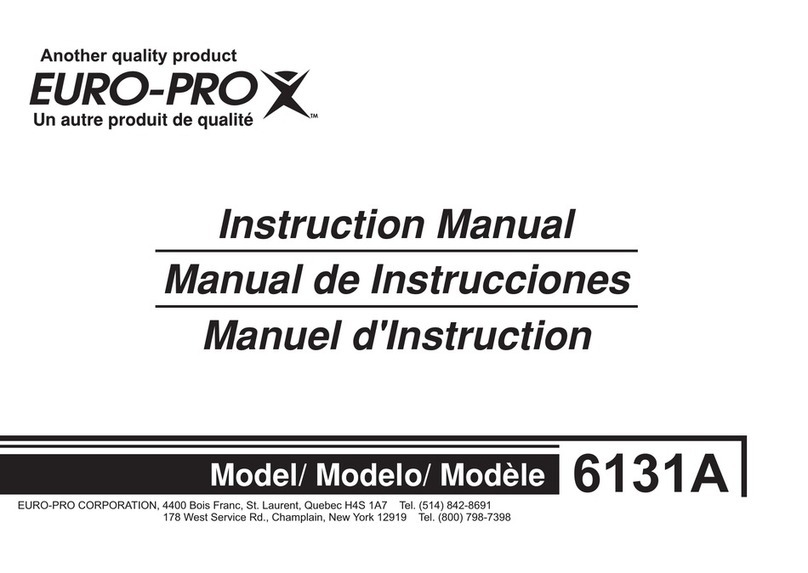
EUROPRO
EUROPRO 6131A User manual
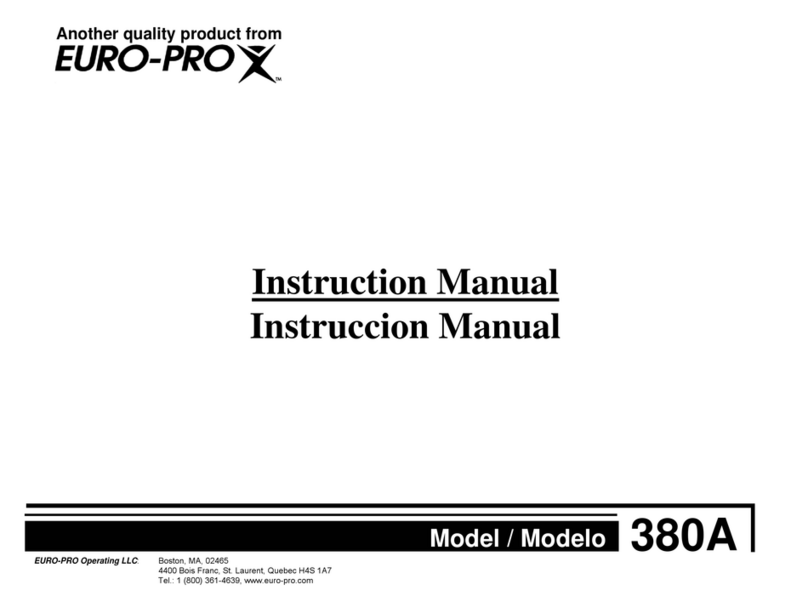
EUROPRO
EUROPRO 380A User manual
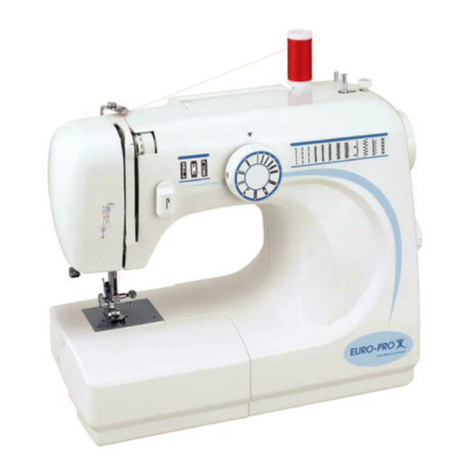
EUROPRO
EUROPRO 385X User manual
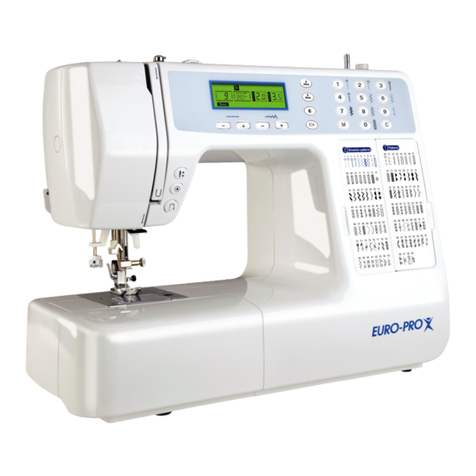
EUROPRO
EUROPRO INTELLI SEW 9136C User manual

EUROPRO
EUROPRO 372 User manual
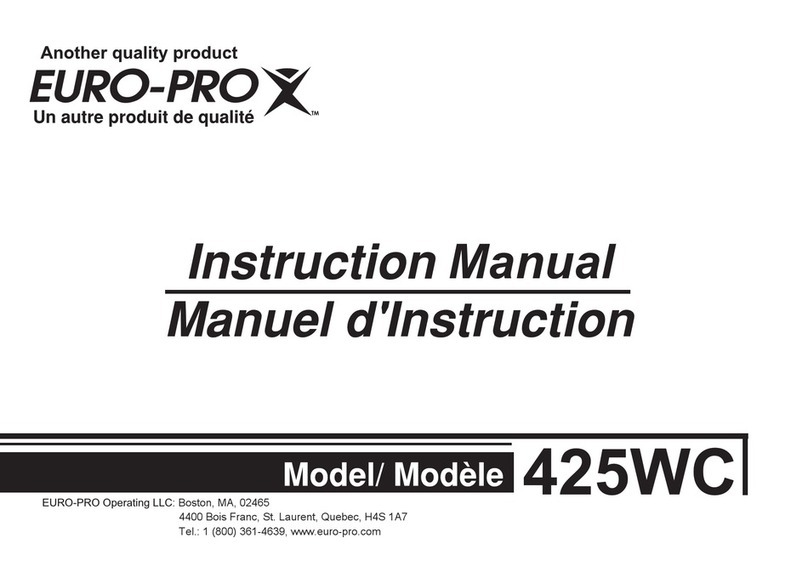
EUROPRO
EUROPRO 425WC User manual
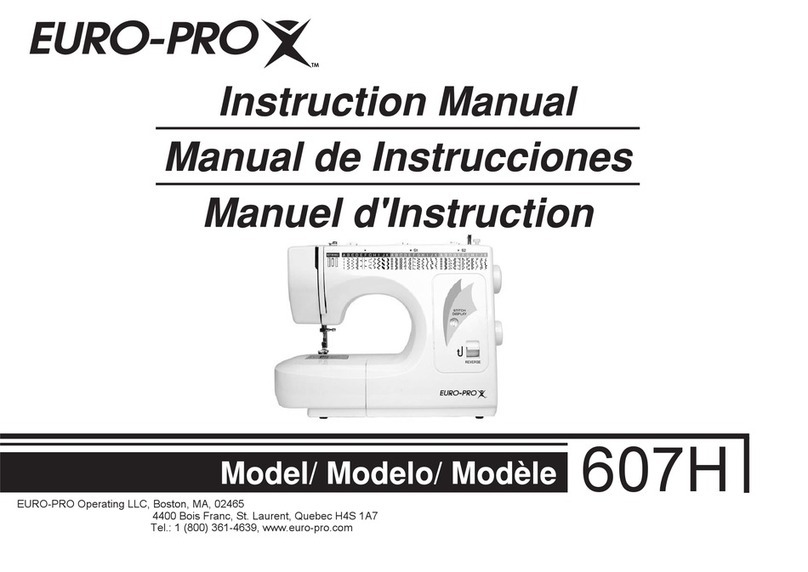
EUROPRO
EUROPRO 607H User manual

EUROPRO
EUROPRO 420 User manual

EUROPRO
EUROPRO 7100 User manual
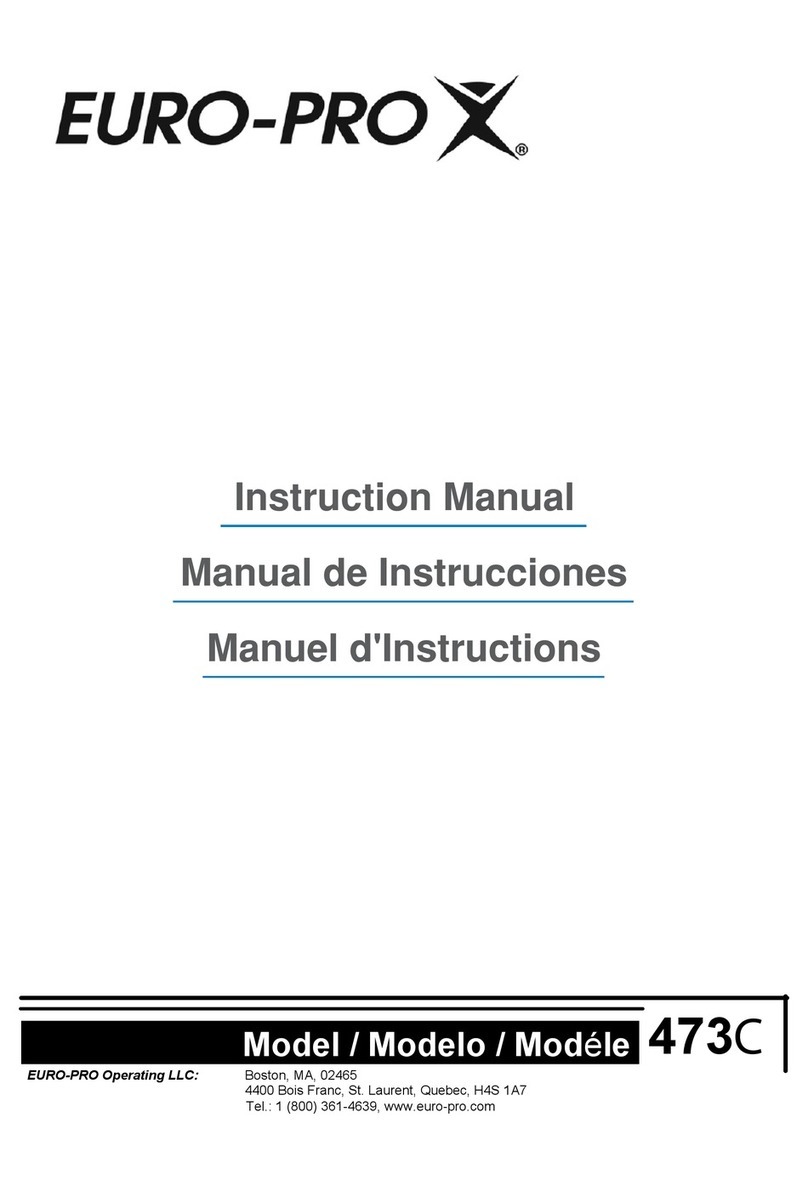
EUROPRO
EUROPRO 473C User manual

EUROPRO
EUROPRO 8260 User manual
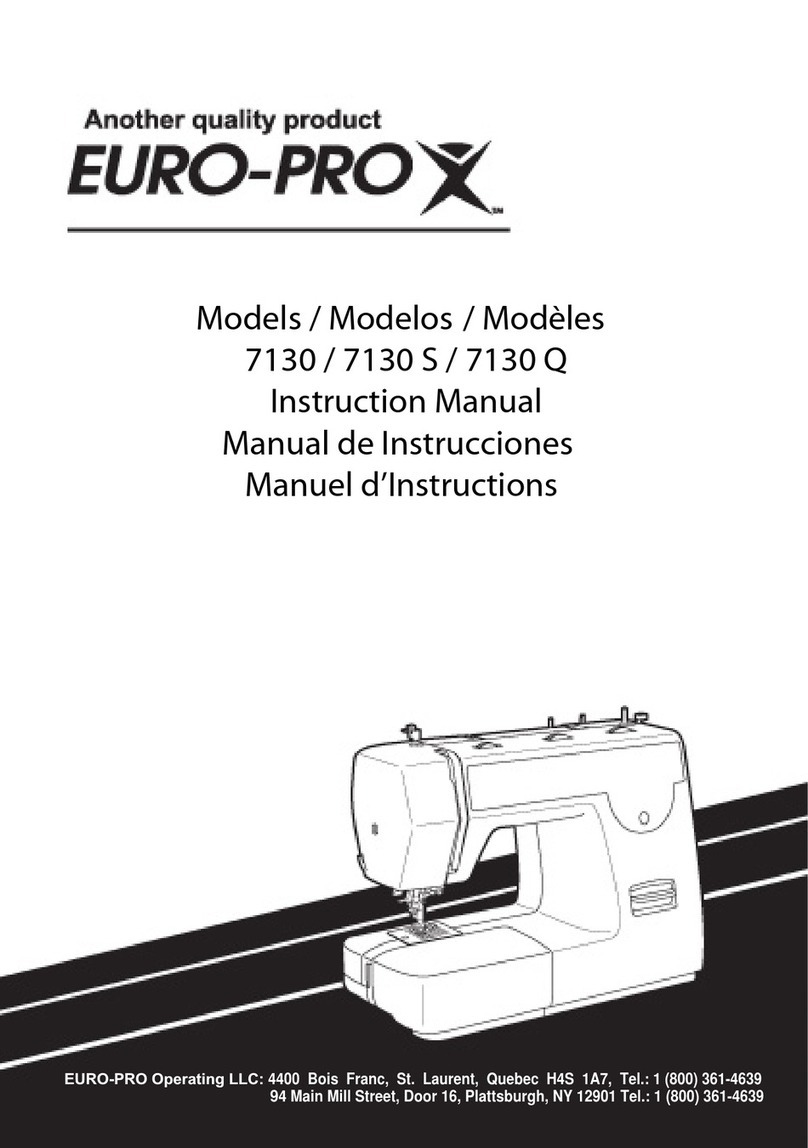
EUROPRO
EUROPRO 7130 User manual
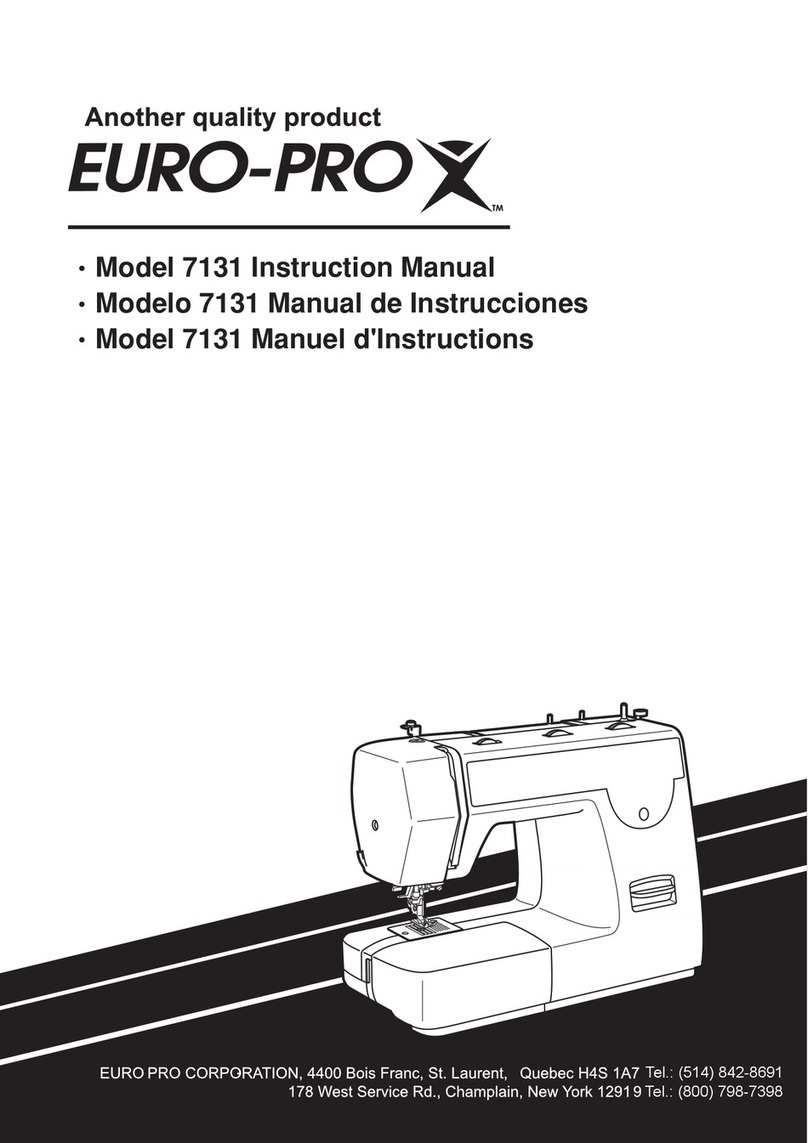
EUROPRO
EUROPRO 7131 User manual

EUROPRO
EUROPRO 9110 User manual

EUROPRO
EUROPRO 415QV User manual

EUROPRO
EUROPRO 534DX User manual
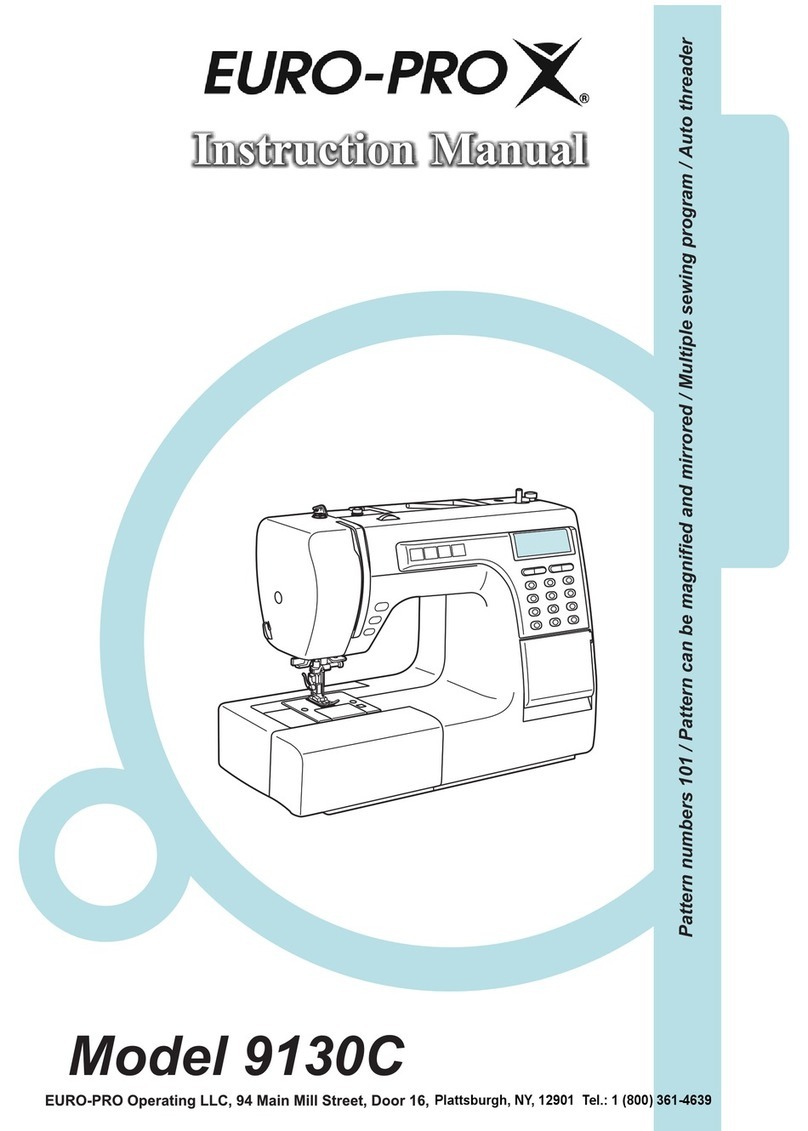
EUROPRO
EUROPRO 9130C User manual
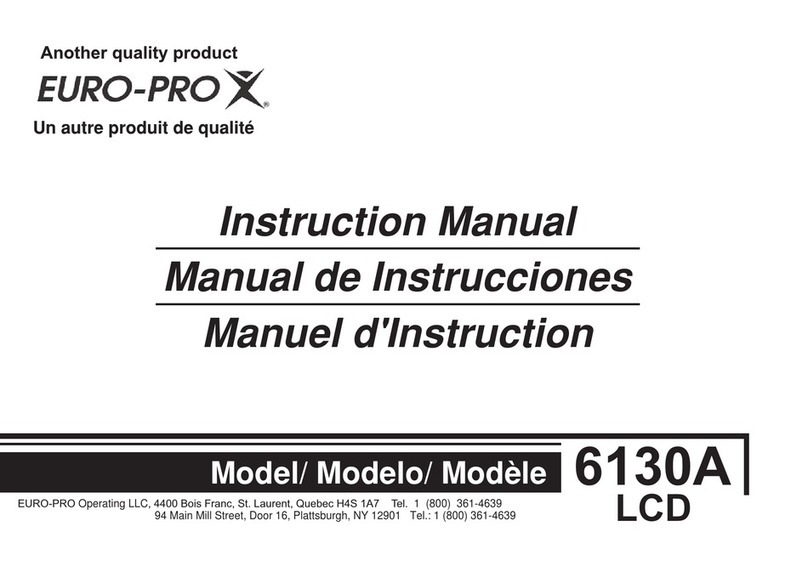
EUROPRO
EUROPRO 6130A User manual
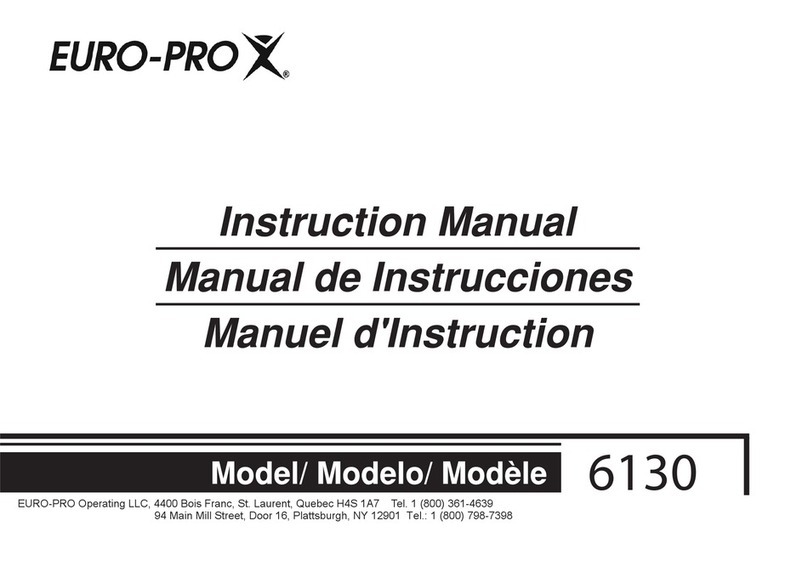
EUROPRO
EUROPRO 6130 User manual
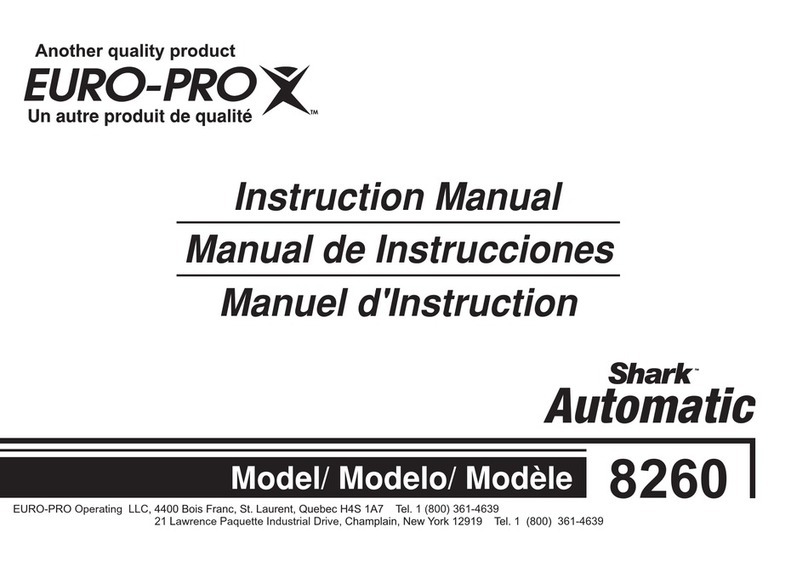
EUROPRO
EUROPRO 8260 User manual
